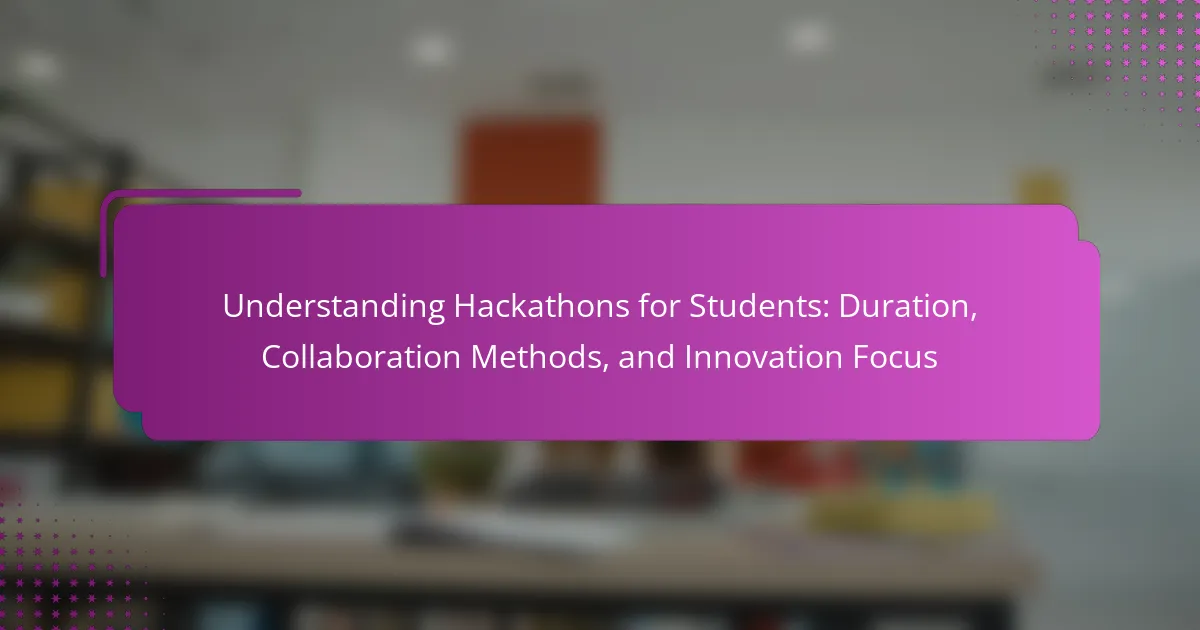Hackathons for students are intensive collaborative events where participants create software or hardware projects within a timeframe of 24 to 48 hours. These events encourage teamwork, creativity, and the development of technical skills, often facilitated by mentorship from industry professionals. Participants engage in various collaboration methods, including brainstorming sessions and pair programming, to foster innovation. The pressure of tight deadlines drives rapid idea generation and unique solutions to specific challenges, making hackathons a valuable educational experience. Successful projects emerging from these events illustrate their effectiveness in promoting experimentation and risk-taking in the pursuit of innovation.
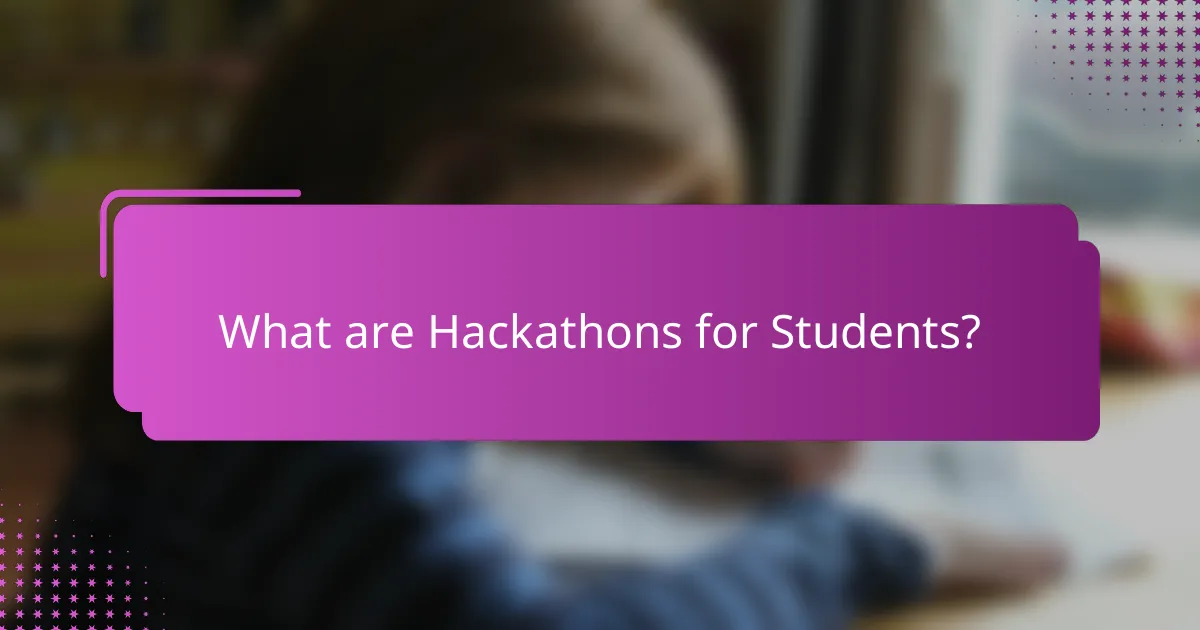
What are Hackathons for Students?
Hackathons for students are collaborative events where participants create software or hardware projects within a set timeframe. These events typically last from 24 to 48 hours. Students work in teams to develop innovative solutions to specific challenges. Hackathons foster creativity, teamwork, and technical skills. They often include mentorship from industry professionals. Participants showcase their projects at the end of the event. Prizes may be awarded for outstanding work. Hackathons are popular in educational institutions as they enhance learning and networking opportunities.
How do Hackathons differ from traditional competitions?
Hackathons differ from traditional competitions primarily in their collaborative nature. Hackathons emphasize teamwork and collective problem-solving. Participants often work in groups to create solutions within a limited timeframe. In contrast, traditional competitions may focus on individual achievements and performance. Hackathons encourage innovation and rapid prototyping, while traditional competitions often prioritize established skills and knowledge. The atmosphere in hackathons is typically more relaxed and experimental. Participants are motivated by creativity rather than just winning. This approach fosters learning and skill development in a supportive environment.
What is the typical format of a student hackathon?
A student hackathon typically follows a structured format. It usually lasts between 24 to 48 hours. Participants form teams to collaborate on projects. Each team works towards developing a software or hardware solution. The event begins with an opening ceremony. This includes introductions and presentations of challenges. Teams then brainstorm and plan their projects. Mentors are available to provide guidance throughout the event. At the end, teams present their projects to judges. Prizes are awarded based on criteria like innovation and functionality. This format encourages creativity and teamwork among students.
What are the key objectives of student hackathons?
The key objectives of student hackathons include promoting innovation and creativity among participants. They aim to enhance problem-solving skills through hands-on challenges. Collaboration is encouraged, allowing students to work in teams and share diverse ideas. Networking opportunities arise, connecting students with industry professionals and mentors. Skill development is a focus, as participants learn new technologies and methodologies. Time management is practiced, as hackathons typically have strict deadlines. Lastly, hackathons foster a competitive spirit, motivating students to push their limits and achieve goals.
Why are Hackathons important for student development?
Hackathons are important for student development because they foster practical skills and collaboration. These events encourage students to apply theoretical knowledge in real-world scenarios. Participants often work in teams, enhancing their communication and teamwork abilities. Hackathons also promote creativity and innovation by challenging students to solve complex problems.
Research indicates that students who engage in hackathons improve their coding and technical skills significantly. A study by the University of California found that participants reported a 30% increase in confidence regarding their programming abilities. Additionally, hackathons provide networking opportunities with industry professionals, which can lead to internships and job offers.
Overall, hackathons serve as a platform for experiential learning, skill enhancement, and professional networking for students.
How do Hackathons foster innovation and creativity?
Hackathons foster innovation and creativity by providing a structured environment for collaboration and rapid prototyping. Participants from diverse backgrounds come together to brainstorm ideas and develop solutions. This collaborative atmosphere encourages out-of-the-box thinking. Time constraints motivate teams to focus on creating functional prototypes quickly. Additionally, hackathons often incorporate mentorship from industry experts, which enhances the learning experience. A study by the University of California found that 70% of participants reported increased creativity after attending a hackathon. This environment stimulates experimentation and risk-taking, essential components of innovation.
What skills can students gain from participating in Hackathons?
Students can gain a variety of skills from participating in hackathons. These skills include problem-solving, as students must find solutions to complex challenges within a limited timeframe. Collaboration is another key skill, as students work in teams to brainstorm and implement ideas. Time management becomes crucial, given the tight deadlines imposed during hackathons.
Additionally, students enhance their technical skills, such as coding and software development, while also learning about project management. Networking opportunities arise, allowing students to connect with industry professionals and peers. Furthermore, creativity is fostered as students are encouraged to think outside the box.
Research shows that participants often report increased confidence in their abilities after completing hackathons. According to a study published in the Journal of Educational Technology, students who engage in hackathons demonstrate improved critical thinking and teamwork skills.
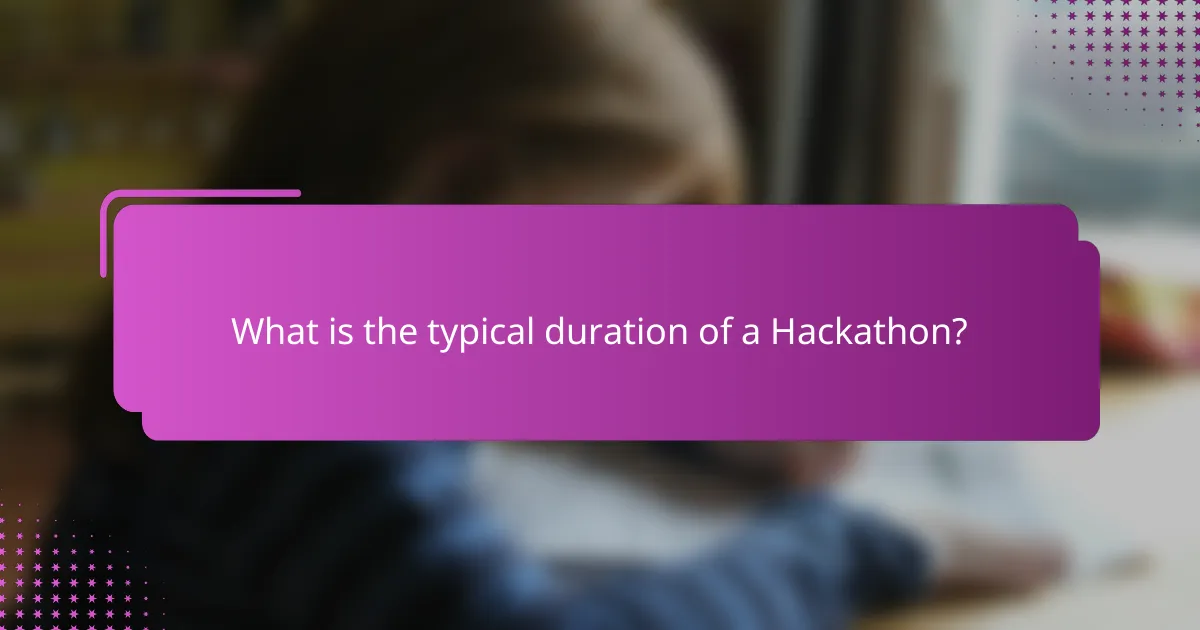
What is the typical duration of a Hackathon?
A hackathon typically lasts between 24 to 48 hours. Some events may extend up to a week, but the most common duration is around one to two days. This timeframe allows participants to brainstorm, develop, and present their projects. The intense schedule encourages rapid innovation and collaboration among team members. Many hackathons start on a Friday evening and conclude on Sunday, maximizing participation. This structure also aligns with the availability of student participants.
How long do student hackathons usually last?
Student hackathons usually last between 24 to 48 hours. This timeframe allows participants to brainstorm, develop, and present their projects. Many hackathons start on a Friday evening and conclude on Sunday. Some events may extend to 72 hours for more complex projects. The duration is designed to encourage intensive collaboration and innovation. This structure is common across various educational institutions and tech organizations.
What factors influence the duration of a hackathon event?
The duration of a hackathon event is influenced by several key factors. The complexity of the projects being developed typically determines how much time participants need. More complex projects require longer durations for completion. The number of participants also impacts duration. Larger teams may need more time to coordinate and collaborate effectively.
Event goals play a significant role in setting the duration. If the aim is to foster innovation, a longer timeframe may be beneficial. Conversely, shorter hackathons may focus on rapid prototyping or specific challenges.
Logistical considerations, such as venue availability and scheduling, also affect the overall duration. Hackathons can range from a few hours to several days based on these logistical factors.
Finally, the format of the hackathon, whether in-person or virtual, can influence time management and participation levels. Each of these factors contributes to determining the appropriate duration for a successful hackathon event.
Are there different formats for hackathon durations?
Yes, there are different formats for hackathon durations. Hackathons can vary in length from a few hours to several days. Common formats include short sprints of 24 hours, weekend-long events, and extended hackathons lasting a week or more. Each format caters to different participant needs and project scopes. For instance, shorter hackathons encourage rapid prototyping, while longer events allow for more in-depth development. The choice of duration impacts team dynamics and project outcomes significantly.
What is the significance of time management during hackathons?
Time management is crucial during hackathons for maximizing productivity and achieving project goals. Effective time management allows teams to allocate specific hours to brainstorming, coding, and testing. It helps in prioritizing tasks to ensure essential features are developed first. Additionally, managing time reduces stress and enhances team collaboration. Research indicates that teams with structured schedules complete projects more successfully. According to a study by the University of California, teams that utilized time management strategies reported higher satisfaction and better outcomes.
How can students effectively manage their time in a hackathon?
Students can effectively manage their time in a hackathon by creating a structured plan. They should begin by defining clear goals for their project. This includes identifying the key features they aim to develop. Next, students should break down tasks into smaller, manageable segments. Assigning specific time limits to each task helps maintain focus.
Using a timer can enhance productivity by creating urgency. Regular check-ins with team members ensure everyone is on track. Prioritizing tasks based on importance and complexity aids in efficient time allocation. Finally, students should remain flexible to adapt their plan as needed.
What strategies can enhance productivity during hackathons?
Effective strategies to enhance productivity during hackathons include clear goal-setting, time management, and team collaboration. Establishing specific, measurable goals helps participants focus their efforts. Time management techniques, such as the Pomodoro Technique, can maintain energy levels and prevent burnout. Encouraging open communication fosters collaboration and idea sharing among team members. Utilizing project management tools, like Trello or Asana, can streamline task assignments and progress tracking. Regular check-ins ensure accountability and allow for adjustments to the workflow. Providing mentorship or access to resources can enhance skill development and problem-solving capabilities. These strategies have been shown to improve outcomes and satisfaction in hackathon settings.
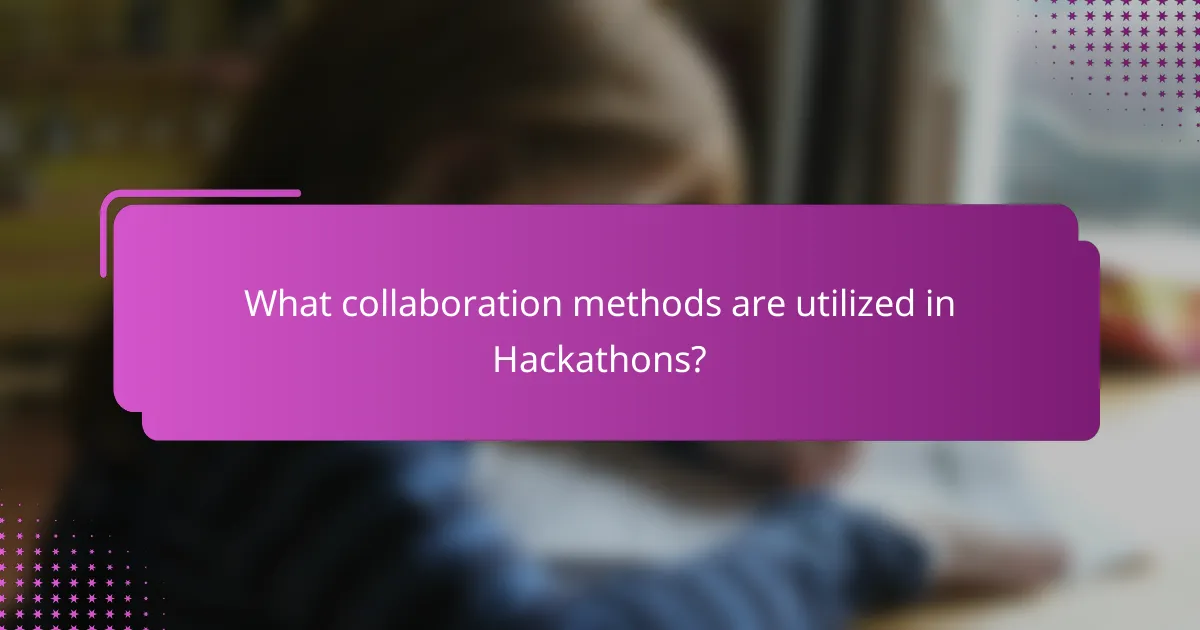
What collaboration methods are utilized in Hackathons?
Hackathons utilize various collaboration methods to enhance teamwork and innovation. Common methods include brainstorming sessions, where participants generate ideas collectively. Pair programming is another approach, allowing two developers to work together on coding tasks. Agile methodologies are often employed to manage projects efficiently during the event. Participants frequently use collaborative tools like Slack or Trello for communication and task management. Additionally, mentorship sessions provide guidance from experienced professionals. These methods foster a dynamic environment conducive to creativity and problem-solving.
How do students typically form teams for Hackathons?
Students typically form teams for hackathons by networking and collaborating with peers. They often meet during pre-event meetups or through online platforms. Many students utilize social media and university groups to connect. Some teams are formed based on complementary skills, such as coding, design, and project management. Students may also join teams based on shared interests in specific technologies or themes. Additionally, hackathon organizers sometimes facilitate team formation through icebreaker activities. Research indicates that diverse skill sets within teams enhance problem-solving abilities and innovation. This collaborative approach fosters a productive environment, leading to successful project outcomes.
What roles do participants usually assume within their teams?
Participants in hackathon teams typically assume roles such as developer, designer, project manager, and presenter. Developers are responsible for coding and building the project. Designers focus on the user experience and visual aspects. Project managers coordinate tasks and ensure deadlines are met. Presenters communicate the project’s vision and outcomes to judges or stakeholders. Each role contributes uniquely to the team’s overall success. This structured approach allows teams to leverage diverse skills effectively.
How can effective communication enhance team collaboration?
Effective communication enhances team collaboration by ensuring clarity and understanding among team members. It allows individuals to share ideas openly and receive constructive feedback. This exchange fosters a sense of belonging and trust within the group. Clear communication reduces misunderstandings and conflicts, leading to more efficient problem-solving. Studies show that teams with strong communication practices are 25% more productive. Effective communication also aligns team goals and objectives, creating a unified direction. When team members feel heard, they are more likely to engage and contribute actively. Overall, effective communication is crucial for fostering a collaborative team environment.
What tools and platforms facilitate collaboration during Hackathons?
Tools and platforms that facilitate collaboration during hackathons include Slack, Trello, GitHub, and Zoom. Slack is a messaging platform that allows teams to communicate in real-time. Trello provides a visual project management tool for organizing tasks. GitHub is essential for version control and code collaboration. Zoom enables virtual meetings for remote teams. These tools enhance communication, task management, and project development. Research shows that effective collaboration tools increase productivity and team cohesion during hackathons.
Which software tools are commonly used for project management?
Commonly used software tools for project management include Asana, Trello, and Microsoft Project. Asana allows teams to track tasks and projects in a collaborative environment. Trello utilizes boards and cards for visual project management. Microsoft Project offers comprehensive planning and scheduling features. Other notable tools are Jira, which is favored for software development projects, and Basecamp, known for its simplicity. These tools enhance productivity by facilitating better organization and communication among team members.
How do online collaboration tools impact team dynamics?
Online collaboration tools enhance team dynamics by facilitating communication and coordination. These tools enable real-time interaction among team members, regardless of their physical location. Improved communication leads to better understanding of tasks and responsibilities. Teams can share documents and resources instantly, increasing efficiency. Enhanced collaboration fosters creativity and innovation among team members. Research shows that teams using collaboration tools report higher satisfaction and productivity levels. For instance, a study by the Harvard Business Review found that effective collaboration can lead to a 25% increase in productivity. This demonstrates the significant positive impact of online collaboration tools on team dynamics.
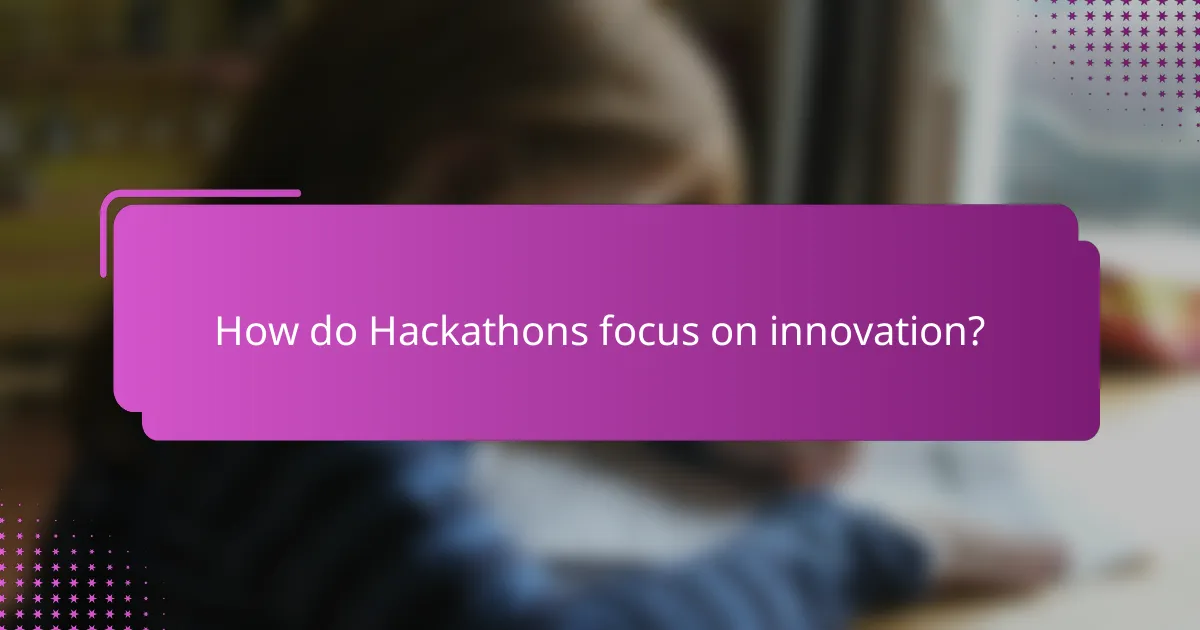
How do Hackathons focus on innovation?
Hackathons focus on innovation by creating a collaborative environment for rapid idea generation and prototyping. Participants form diverse teams to tackle specific challenges. This diversity encourages unique perspectives and creative solutions. Time constraints push teams to think quickly and outside the box. Hackathons often provide access to resources and mentorship, enhancing the innovation process. Many successful products have emerged from hackathons, demonstrating their effectiveness in fostering creativity. For instance, the first version of Twitter originated from a hackathon. This model encourages experimentation and risk-taking, vital for innovation.
What themes are commonly explored in student hackathons?
Common themes explored in student hackathons include technology innovation, social impact, and sustainability. Technology innovation often focuses on software development, app creation, and hardware projects. Social impact themes address issues like education, healthcare, and community development. Sustainability themes promote environmental awareness and solutions for climate change. Hackathons also frequently explore themes related to artificial intelligence and machine learning. Participants engage in collaborative problem-solving to tackle real-world challenges. These themes reflect current trends and student interests in the tech landscape.
How do hackathons encourage new ideas and problem-solving?
Hackathons encourage new ideas and problem-solving by fostering a collaborative environment. Participants come together to brainstorm and develop solutions within a limited timeframe. This urgency promotes creativity and quick thinking. Diverse teams often generate a wider range of perspectives. The competitive aspect motivates individuals to push their limits. Access to mentors provides guidance and expertise. Resources like tools and technology are often available to facilitate innovation. According to research by the University of California, hackathons lead to a significant increase in creative output and problem-solving skills among participants.
What role does mentorship play in fostering innovation during hackathons?
Mentorship plays a crucial role in fostering innovation during hackathons. Mentors provide guidance, expertise, and support to participants. Their experience helps teams navigate complex challenges. Mentors also encourage creative thinking and problem-solving. Research shows that mentorship increases the likelihood of successful project outcomes. A study by the MIT Media Lab found that teams with mentors produced more innovative solutions. Mentorship also enhances collaboration among team members. This creates a more dynamic and resourceful environment for innovation. Overall, mentorship significantly boosts the potential for groundbreaking ideas during hackathons.
What are some successful examples of innovative projects from hackathons?
Successful examples of innovative projects from hackathons include Slack, GroupMe, and Instagram. Slack started as a game development project and evolved into a leading team collaboration tool. GroupMe was created during a hackathon at TechCrunch Disrupt and quickly gained popularity for group messaging. Instagram originated as a photo-sharing app called Burbn, developed during a hackathon, before pivoting to its current form. These projects demonstrate how hackathons can foster creativity and lead to significant technological advancements.
How can these projects inspire future participants?
These projects can inspire future participants by showcasing innovative solutions and collaborative teamwork. Participants witness firsthand how diverse skills contribute to successful outcomes. They also see the potential for real-world impact through creative problem-solving. The competitive yet supportive environment fosters motivation and encourages risk-taking. Success stories from past projects serve as tangible examples of achievable goals. Additionally, mentorship opportunities highlight the value of guidance and experience. Engaging with industry professionals during these events can spark interest in various career paths. Overall, the experience cultivates a sense of community and shared purpose, driving future participants to get involved.
What lessons can be learned from past hackathon innovations?
Past hackathon innovations teach valuable lessons about collaboration, creativity, and rapid problem-solving. Teams often produce innovative solutions in a short time frame. This highlights the importance of focused teamwork under pressure. Hackathons encourage diverse skill sets, promoting interdisciplinary collaboration. Participants learn to pivot ideas quickly based on feedback. The iterative design process fosters resilience and adaptability. Successful projects often emerge from unexpected combinations of ideas and technologies. These experiences underline the significance of community support and networking in driving innovation.
What are best practices for maximizing the Hackathon experience?
To maximize the Hackathon experience, participants should focus on effective teamwork and clear communication. Forming a diverse team with varied skills enhances creativity and problem-solving. Setting specific, achievable goals at the outset keeps the group focused. Time management is crucial; allocate time for brainstorming, development, and testing. Utilizing project management tools can streamline collaboration. Engaging with mentors can provide valuable insights and guidance. Lastly, actively participating in networking opportunities can lead to future collaborations and career growth. These practices are supported by successful Hackathon outcomes, where structured approaches often lead to innovative solutions and high-quality projects.
Hackathons for students are collaborative events where participants develop software or hardware projects within a set timeframe, typically lasting 24 to 48 hours. These events emphasize teamwork, innovation, and skill development, often featuring mentorship from industry professionals. The article covers the structure and objectives of student hackathons, their significance for student development, and the various collaboration methods utilized. Additionally, it explores the importance of time management, effective communication, and the impact of mentorship on fostering creativity and problem-solving during these events.
